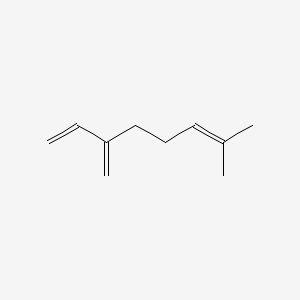| Authors | Title | Published | Journal | PubMed Link |
|---|---|---|---|---|
| Cesta MF et al. | Complex histopathologic response in rat kidney to oral β-myrcene: an unusual dose-related nephrosis and low-dose alpha2u-globulin nephropathy. | 2013 | Toxicol Pathol | pmid:23531794 |
| Li XB et al. | [Composition and antitumor activities of essential oil from the fruits of Dasymaschalon trichophorum]. | 2013 | Zhong Yao Cai | pmid:24956819 |
| Moradi M et al. | Comparison of headspace solid-phase microextraction, headspace single-drop microextraction and hydrodistillation for chemical screening of volatiles in Myrtus communis L. | 2012 Jul-Aug | Phytochem Anal | pmid:22069217 |
| Cai GX et al. | Comparative analysis of essential oil components of Evodia rutaecarpa (Juss.) Benth. var. officinalis (Dode) Huang and Evodia rutaecarpa (Juss.) Benth. | 2012 | Nat. Prod. Res. | pmid:22007871 |
| Verma RS et al. | Volatile constituents of Origanum vulgare L., 'thymol' chemotype: variability in North India during plant ontogeny. | 2012 | Nat. Prod. Res. | pmid:22011270 |
| Lüddeke F et al. | Physiology of deletion mutants in the anaerobic β-myrcene degradation pathway in Castellaniella defragrans. | 2012 | BMC Microbiol. | pmid:22947208 |
| Jayaprakasha GK et al. | Inhibition of prostate cancer (LNCaP) cell proliferation by volatile components from Nagami kumquats. | 2012 | Planta Med. | pmid:22673830 |
| Yvon Y et al. | Relation between chemical composition or antioxidant activity and antihypertensive activity for six essential oils. | 2012 | J. Food Sci. | pmid:22860587 |
| Zheljazkov VD et al. | Distillation time alters essential oil yield, composition, and antioxidant activity of male Juniperus scopulorum trees. | 2012 | J Oleo Sci | pmid:23018851 |
| Amiri H | Essential oils composition and antioxidant properties of three thymus species. | 2012 | Evid Based Complement Alternat Med | pmid:21876714 |
Myrcene
Myrcene is a lipid of Prenol Lipids (PR) class. Myrcene is associated with abnormalities such as Hypomenorrhea, abnormal fragmented structure, Nephrosis, Renal tubular disorder and Kidney Diseases. The involved functions are known as Anabolism, Gene Expression, Protein Biosynthesis, Mutation and Selection, Genetic. Myrcene often locates in Plastids, Proboscis, Body tissue, Clone and soluble. The associated genes with Myrcene are TTPA gene, monoterpene synthase, Genome, 4S-limonene synthase and Homologous Gene. The related lipids are Pinene, Octanols, Membrane Lipids and Fatty Acids, Unsaturated.
Cross Reference
Introduction
To understand associated biological information of Myrcene, we collected biological information of abnormalities, associated pathways, cellular/molecular locations, biological functions, related genes/proteins, lipids and common seen animal/experimental models with organized paragraphs from literatures.
What diseases are associated with Myrcene?
Myrcene is suspected in Nephrosis, Kidney Diseases, Dehydration, Hypomenorrhea, Renal tubular disorder and other diseases in descending order of the highest number of associated sentences.
Related references are mostly published in these journals:
| Disease | Cross reference | Weighted score | Related literature |
|---|
No disease MeSH terms mapped to the current reference collection.
PubChem Associated disorders and diseases
What pathways are associated with Myrcene
There are no associated biomedical information in the current reference collection.
PubChem Biomolecular Interactions and Pathways
Link to PubChem Biomolecular Interactions and PathwaysWhat cellular locations are associated with Myrcene?
Visualization in cellular structure
Associated locations are in red color. Not associated locations are in black.
Related references are published most in these journals:
| Location | Cross reference | Weighted score | Related literatures |
|---|
What functions are associated with Myrcene?
Related references are published most in these journals:
| Function | Cross reference | Weighted score | Related literatures |
|---|
What lipids are associated with Myrcene?
Related references are published most in these journals:
| Lipid concept | Cross reference | Weighted score | Related literatures |
|---|
What genes are associated with Myrcene?
Related references are published most in these journals:
| Gene | Cross reference | Weighted score | Related literatures |
|---|
What common seen animal models are associated with Myrcene?
There are no associated biomedical information in the current reference collection.
